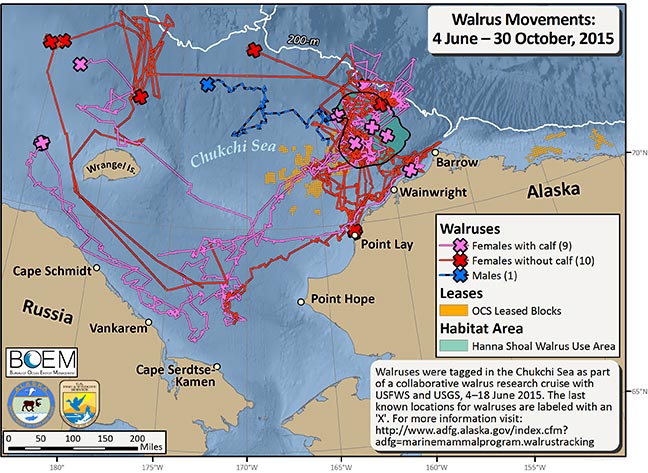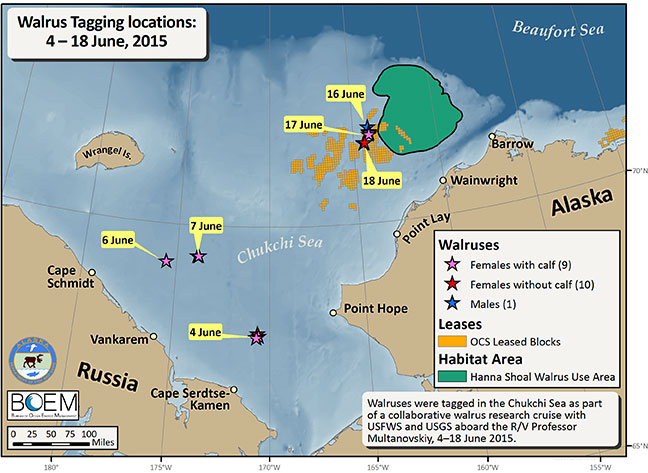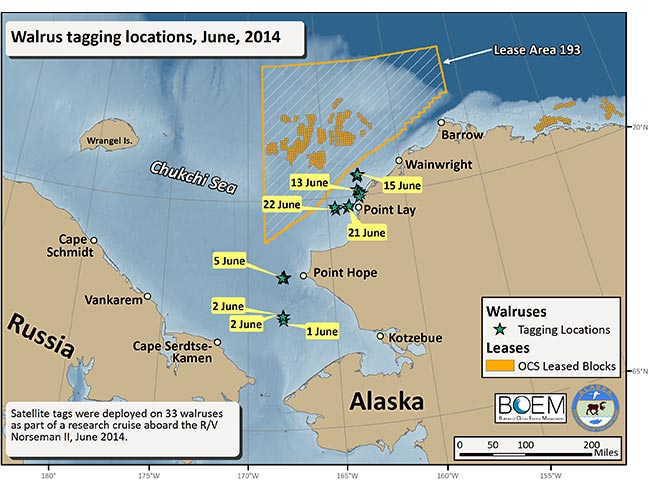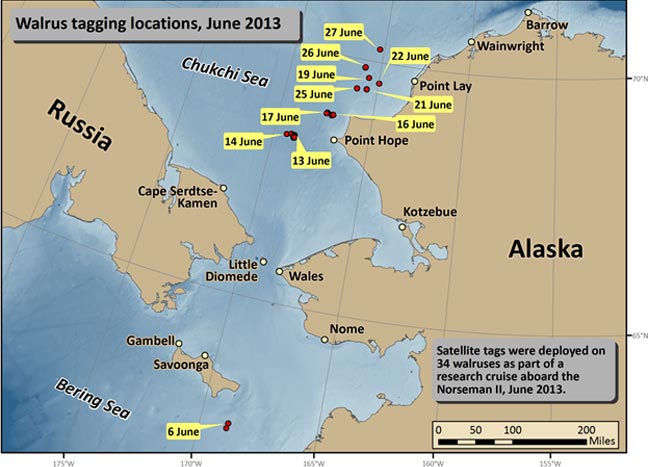Walrus Research Projects
Village-based Walrus Habitat Use Studies in the Chukchi Sea
We are pleased to announce that the Arctic Marine Mammal Program of the Alaska Department of Fish and Game worked with a walrus hunter from St. Lawrence Island to deploy satellite transmitters on walruses in June. As part of a collaborative walrus research cruise with USFWS and USGS from 27 May to 25 June 2015, we deployed 20 transmitters on females (10 of which had calves of the year) and one transmitter on a male walrus. Tags were deployed 4–18 June in the Chukchi Sea, on both the U.S. and Russian sides of the Chukchi Sea.
Clarence Irrigoo from Gambell participated in the research cruise and helped deploy tags and collect biopsies. This project benefited considerably from his hunting skills and his knowledge of walrus behavior. Furthermore, we would like to thank the crew of the R/V Professor Multanovskiy for their competent ship support. Funding for this project is provided by the Bureau of Ocean Energy Management (BOEM). We plan to track the movements of these walruses, in general, and relative to oil and gas activities in the lease sale area in the Chukchi Sea.
Most Recent Walrus Tracking Map

Over the last five months, the deployed tags transmitted for an average of 56 days, ranging from 1 to 134 days. During this time we received an average of 234 locations (15–456 locations) per walrus. Walruses traveled, on average, a minimum distance of 1,388 km (862 miles), ranging from 33–3,348 km (21–2,080 miles). At a minimum, these walruses traveled, an average of 25 km (15.5 miles) per day.
Animation of Walrus Locations and Sea Ice in 2015
See also: Animation of Walrus Locations and Sea Ice in 2014
Walrus Tracking Maps Archive
2015
- Summary Map
- 10/23/2015 – 11/02/2015
- 10/16/2015 – 10/26/2015
- 10/10/2015 – 10/20/2015
- 10/03/2015 – 10/12/2015
- 09/26/2015 – 10/05/2015
- 09/18/2015 – 09/28/2015
- 09/11/2015 – 09/21/2015
- 09/04/2015 – 09/14/2015
- 08/30/2015 – 09/08/2015
- 08/21/2015 – 08/31/2015
- 08/14/2015 – 08/24/2015
- 08/07/2015 – 08/17/2015
- 08/03/2015 – 08/10/2015
- 07/20/2015 – 08/03/2015
- 07/10/2015 – 07/20/2015
- 07/03/2015 – 07/13/2015
- 06/27/2015 – 07/06/2015
- 06/04/2015 – 06/26/2015
2014
- Summary Map
- 06/01/2014 – 10/27/2014
- 09/27/2014 – 10/06/2014
- 09/19/2014 – 09/29/2014
- 09/12/2014 – 09/22/2014
- 09/05/2014 – 09/15/2014
- 08/30/2014 – 09/08/2014
- 08/24/2014 – 09/02/2014
- 08/16/2014 – 08/26/2014
- 08/08/2014 – 08/18/2014
- 08/01/2014 – 08/11/2014
- 07/25/2014 – 08/04/2014
- 07/14/2014 – 07/28/2014
- 07/07/2014 – 07/17/2014
- 07/01/2014 – 07/11/2014
- 07/01/2014 – 07/11/2014
- 06/01/2014 – 07/01/2014
2013
- Summary Map
- 10/08/2013 – 10/22/2013
- 10/01/2013 – 10/10/2013
- 09/26/2013 – 10/02/2013
- 09/16/2013 – 09/26/2013
- 09/09/2013 – 09/19/2013
- 09/01/2013 – 09/11/2013
- 08/27/2013 – 09/04/2013
- 08/17/2013 – 08/27/2013
- 08/11/2013 – 08/21/2013
- 08/04/2013 – 08/14/2013
- 07/30/2013 – 08/08/2013
- 07/21/2013 – 07/31/2013
- 07/14/2013 – 07/24/2013
- 07/06/2013 – 07/17/2013
- 06/06/2013 – 07/09/2013
Project Overview
Pacific walruses (Odobenus rosmarus) are an important subsistence and cultural resource for coastal people of western Alaska and they are an important component of the Bering and Chukchi seas ecosystem. Walruses winter together in the Bering Sea but females with calves and subadults summer in the Chukchi Sea using sea ice as a resting platform while feeding on the shallow sea floor; whereas most adult males remain in the Bering Sea where they use terrestrial haulouts for resting. The rapid retreat of sea ice in recent years is changing walrus summer habitat in the Chukchi Sea and may be changing summer distribution and haulout behavior, requiring that walruses haul out on land instead of ice. Oil and gas activity has recently increased in the Chukchi Sea, increasing the importance of improving our understanding of walrus movements, feeding behavior, and habitat requirements to develop effective mitigation measures for the conservation and management of the species. Satellite-linked transmitters placed on walruses near the communities of Little Diomede, Shishmaref, Point Hope, Point Lay, Wainwright, and Barrow in spring, summer, and fall would provide information on movements, speed of travel, feeding areas, and haulout behavior. Working cooperatively with the Eskimo Walrus Commission and walrus hunters from these communities, we have designed a study to deploy satellite transmitters and conduct counts and observations of walruses on haulouts near villages in spring and fall. Traditional ecological knowledge will also be collected and integrated into the results. These data will provide information that will help answer important questions about walrus movements, feeding areas, haulout behavior, migration timing, and body condition that will improve our understanding of habitats important to walruses. The study will be conducted over a 5-year period, is designed so that is does not interfere with subsistence walrus hunting activities and is funded by the Bureau of Ocean Energy Management (BOEM).
Products: Abstracts, Posters, and Presentations
- Project update to Eskimo Walrus Commission, December 2010. (PDF 118 kB)
- Quakenbush, L., W. Neakok, J. Crawford, A. Bryan, and M. Nelson. 2011. Results from village-based walrus studies in Alaska, 2010. Alaska Marine Science Symposium, 17-21 January, Anchorage, AK. (Abstract and poster). (PDF 311 kB)
- 2011 Haulout Report for Point Lay (Prepared by USFWS). (PDF 864 kB)
- Crawford, J. A., W. Neakok, J. Garlich-Miller, M. A. Nelson, and L. T. Quakenbush. 2012. Results from village-based walrus studies in Alaska, 2011. Alaska Marine Science Symposium, 16-20 January, Anchorage, AK. (Abstract and poster). (PDF 238 kB)
- Crawford, J. A., W. Neakok, M. A. Nelson, J. Garlich-Miller, and L. T. Quakenbush. 2013. Results from village-based walrus studies in Alaska, 2012. Alaska Marine Science Symposium, 21-25 January, Anchorage, AK. (Abstract and poster). (PDF 238 kB)
- Project update to Eskimo Walrus Commission, December 2013. (PDF 215 kB)
- Crawford, J. A., L. T. Quakenbush, C. Irrigoo, P. Pungowiyi, W. Neakok, and J. Garlich-Miller. 2014. Results from village-based walrus studies in Alaska, 2013. Alaska Marine Science Symposium, 20-24 January, Anchorage, AK. (Abstract and poster). (PDF 304 kB)
- Project update to Eskimo Walrus Commission, December 2014. (PDF 294 kB)
- Crawford, J. A., L. T. Quakenbush, C. Irrigoo, E. Noongwook, and J. Garlich-Miller. 2015. Results from village-based walrus studies in Alaska, 2014. Alaska Marine Science Symposium, 19-22 January, Anchorage, AK. (Abstract and poster). (PDF 305 kB)
- Project update to Eskimo Walrus Commission, December 2015. (PDF 231 kB)
- Crawford, J. A., L. T. Quakenbush, J. J. Citta, C. Irrigoo Jr. and P. R. Lemons. 2015. Using movement, diving and haul out behavior to identify the relative importance of foraging areas for walruses in the Alaskan Chukchi Sea. 21th Biennial Conference on the Biology of Marine Mammals. 14-18 December, 2015. San Francisco, CA, USA. (Abstract and oral presentation). (PDF 14 kB)
- Crawford, J. A., L. T. Quakenbush, J. J. Citta, C. Irrigoo Jr. and P. R. Lemons. 2016. Using movement, diving and haul out behavior to identify the relative importance of foraging areas for walruses in the Alaskan Chukchi Sea. Alaska Marine Science Symposium, 25-29 January, Anchorage, AK. (Abstract and poster). (PDF 334 kB)
- Quakenbush, L. T., J. A. Crawford, J. J. Citta, M. N. Nelson. 2016. Pinniped movements and foraging: village-based walrus habitat use studies in the Chukchi Sea. U.S. Dept. of the Interior, Bureau of Ocean Energy Management, Alaska Outer Continental Shelf Region, Anchorage, AK. OCS Study BOEM 2016-053. 82 pp + appendices. (PDF 2,200 kB)
Tagging Activities in 2015
As part of a collaborative walrus research cruise with USFWS and USGS from 27 May to 25 June 2015, we deployed 20 transmitters on females (10 of which had calves of the year) and one transmitter on a male walrus. Tags were deployed 4–18 June in the Chukchi Sea, on both the U.S. and Russian sides of the Chukchi Sea. Of the 21 transmitters, 11 were Splash10 tags and 10 were SPOT6 tags. The Splash10 tags provide dive information in addition to locations and the SPOT6 tags provide location data. We will prepare weekly maps of the locations of tagged walruses and distribute them via e-mail to the Eskimo Walrus Commission, hunters, agencies, oil industry personnel, and anyone interested in receiving them.

A walrus hunter from St. Lawrence Island, Clarence Irrigoo, participated in the research cruise and were trained to deploy tags and collect biopsies. This project benefited considerably from his hunting skills and his knowledge of walrus behavior. Funding for this project is provided by the Bureau of Ocean Energy Management (BOEM).
Tagging Activities in 2014
As part of a walrus research cruise with USGS and USFWS from 28 May to 29 June 2014 we deployed 33 satellite-linked transmitters; 31 on females (12 of which had calves of the year) and two on males. Tags were deployed 1–23 June in the Chukchi Sea (Fig. 1). Of the 33 transmitters, 23 were Splash10 tags and 10 were SPOT tags. The Splash10 tags provide dive information in addition to locations and the SPOT tags provide location data. We will prepare weekly maps of the locations of tagged walruses and distribute them via e-mail to the Eskimo Walrus Commission, hunters, agencies, oil industry personnel, and anyone interested in receiving them.

Two walrus hunters from St. Lawrence Island, Clarence Irrigoo from Gambell (Fig. 2) and Edwin Noongwook from Savoonga (Fig. 3), participated in the research cruise and were trained to deploy tags and collect biopsies. This project benefited considerably from their hunting skills and their knowledge of walrus behavior. Funding for this project is provided by the Bureau of Ocean Energy Management (BOEM).
Tagging Activities in 2013
As part of a walrus research cruise with USGS and USFWS from 4 June to 1 July 2013 we deployed 34 satellite-linked transmitters; 28 on females (13 of which had calves of the year) and six on males. Tags were deployed 6 – 27 June from near St. Lawrence Island in the Bering Sea to near Pt. Lay in the Chukchi Sea (Fig. 4). Of the 34 transmitters, 21 were Splash10 tags and 13 were SPOT tags. The Splash10 tags provide dive information in addition to locations and the SPOT tags provide location data. We will prepare weekly maps of the locations of tagged walruses and distribute them via e-mail to the Eskimo Walrus Commission, hunters, agencies, oil industry personnel, and anyone interested in receiving them.

Two walrus hunters from St. Lawrence Island, Clarence Irrigoo form Gambell (Fig. 5) and Perry Pungowiyi from Savoonga (Fig. 6), participated in the research cruise and were trained to deploy tags and collect biopsies. This project benefited considerably from their hunting skills and their knowledge of walrus behavior. Funding for this project is provided by the Bureau of Ocean Energy Management (BOEM).
